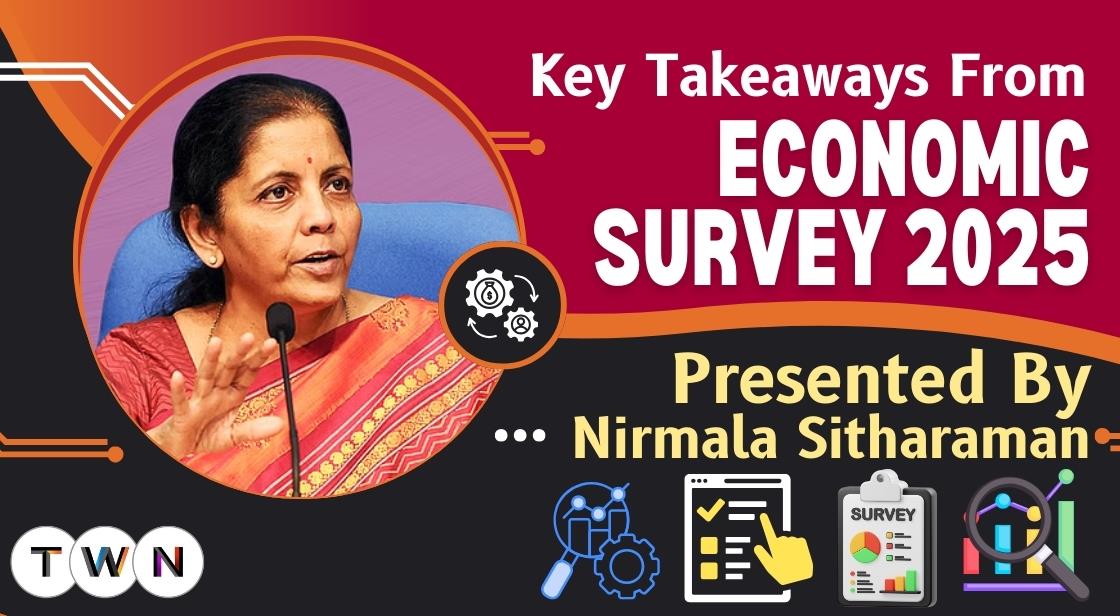Key Takeaways from Economic Survey 2025 Presented by Nirmala Sitharaman

Blog Post
The Economic Survey 2025, presented by Finance Minister Nirmala Sitharaman on January 31, 2025, provides an in-depth analysis of India’s economic performance, key policy measures, and future growth prospects.
Prepared by the Economic Division of the Department of Economic Affairs (DEA) under the guidance of Chief Economic Advisor (CEA) V. Anantha Nageswaran, the survey outlines India's resilience amid global uncertainties while highlighting macroeconomic stability, sectoral growth, and policy directions.
With India’s GDP projected to grow at 6.4% in FY 2024-25, the survey underscores steady expansion across agriculture, industry, and services, controlled inflation, strengthening foreign exchange reserves, and robust banking sector performance.
Additionally, it calls for deregulation, enhanced private sector participation in infrastructure, and a strategic trade roadmap to bolster India’s global competitiveness.
This report serves as a crucial reference for policymakers, investors, and industry leaders, offering valuable insights into India’s economic trajectory and its vision for Viksit Bharat@2047.
In this blog, we will delve into the key takeaways from the Economic Survey 2025, highlighting major trends, challenges, and opportunities shaping India's economic future.
Economic Survey 2025 Report by Nirmala Sitharaman: Key Trends and Insights
What is the Economic Survey?
The Economic Survey serves as a comprehensive report on the Indian economy's performance, government policies, and future outlook for the upcoming financial year. It is prepared by the Economic Division of the Department of Economic Affairs (DEA) under the Ministry of Finance, led by Chief Economic Advisor (CEA) V. Anantha Nageswaran. The survey provides a detailed analysis of macroeconomic trends, fiscal policies, and socio-economic issues.
Finance Minister Nirmala Sitharaman presented the Economic Survey 2025 in Parliament on Friday, January 31, 2025. This survey comes just six months after the 2022-23 Economic Survey, which was presented in July 2024 following the General Election.
Structure of the Economic Survey
The Economic Survey is divided into two sections:
-
Part A: Focuses on macroeconomic performance, fiscal trends, and growth projections.
-
Part B: Examines socio-economic issues such as poverty, education, climate change, inflation, trade, and overall economic outlook.
What is the Department of Economic Affairs (DEA)
The Department of Economic Affairs (DEA) is a key department under the Ministry of Finance, Government of India. It is responsible for formulating and implementing India’s economic policies, managing public finances, and overseeing financial regulations.
Key Functions of the DEA:
-
Economic Policy & Analysis: Monitors macroeconomic trends and formulates policies to promote economic growth.
-
Budget Management: Prepares the Union Budget and Economic Survey.
-
Capital Markets & Investment: Regulates financial markets and foreign investments.
-
Public Debt & External Finance: Manages government borrowings and foreign aid.
-
Infrastructure & Sustainable Development: Oversees economic reforms in key sectors like energy and infrastructure.
The DEA is headed by the Secretary of Economic Affairs and includes the Chief Economic Advisor (CEA), who plays a vital role in drafting the Economic Survey of India.
10 Key Highlights of the Economic Survey 2025
1. India's Economy to Remain Stable
Resilience Amid Global Uncertainty
Despite prevailing global uncertainties, India's economy continues to demonstrate resilience. The Economic Survey 2025 projects a real GDP growth of 6.4% for the financial year 2024-25, aligning closely with the decadal average. This steady growth is further reinforced by a corresponding 6.4% expansion in real Gross Value Added (GVA), reflecting sustained economic stability across sectors.
Also Read: The Biggest IPOs of 2025: A Glimpse into the Future of Indian Markets
2. All Sectors Contributing to Growth
Agriculture Sector Maintaining Strength
The survey highlights the robust performance of the agriculture sector, which has consistently operated above trend levels, ensuring stability in food production and rural employment.
Industrial Sector Regaining Momentum
The industrial sector has surpassed its pre-pandemic trajectory, indicating a revival in manufacturing, construction, and mining activities. This resurgence has positively impacted employment and production capabilities.
Services Sector Approaching Trend Levels
India's services sector has exhibited a strong recovery, approaching its historical trend levels. The sector's revival is fueled by increased domestic consumption, digital adoption, and global demand for IT and business services.
3. Inflation Under Control
Declining Retail Inflation
Retail headline inflation reduced from 5.4% in FY 2023-24 to 4.9% during April-December 2024-25. This downward trend is attributed to proactive monetary policies and improved supply chain management.
Inflation Projections and Management
Both the Reserve Bank of India (RBI) and the International Monetary Fund (IMF) anticipate further alignment of consumer price inflation towards the target of 4% by FY 2026. This reflects effective inflation control mechanisms and fiscal prudence.
4. Foreign Investment Trends: FPI and FDI
Mixed Trends in Foreign Portfolio Investments (FPI)
FPI inflows have witnessed fluctuations due to global market uncertainties and profit-taking by foreign investors. However, strong macroeconomic fundamentals and a conducive business environment have maintained a positive overall FPI trend.
Revival in Foreign Direct Investment (FDI)
Gross FDI inflows have shown signs of recovery during the first eight months of FY 2024-25. Although net FDI inflows have declined relative to April-November 2023 due to increased repatriation, India's long-term investment attractiveness remains intact.
5. Strengthening Forex Reserves
High Foreign Exchange Reserves
India's forex reserves peaked at $706 billion in September 2024 before settling at $640.3 billion by December 27, 2024. These reserves cover approximately 89.9% of the nation's external debt, reinforcing India's financial stability and global creditworthiness.
6. Banking and Insurance Sector Stability
Declining Non-Performing Assets (NPAs)
The banking sector has witnessed a consistent decline in the Gross Non-Performing Assets (GNPA) ratio, dropping to 2.6% by September 2024 from its peak in FY 2018. This indicates improved credit quality and financial discipline.
Sustainable Bank Credit Growth
The credit-GDP gap narrowed significantly to 0.3% in Q1 FY 2024-25 from -10.3% in the previous year, highlighting the sustainability of recent credit expansion.
Growth in Insurance and Pension Sectors
Insurance premiums grew by 7.7% in 2023-24, reaching ₹11.2 lakh crore. The total number of pension subscribers increased by 16% year-on-year as of September 2024, showcasing heightened financial inclusion and long-term savings trends.
7. Growth in Exports
Rise in Merchandise and Services Exports
India's total exports (merchandise and services) rose to $602.6 billion during the first nine months of FY 2024-25, marking a 6% increase. Excluding petroleum and gems and jewelry, export growth stood at 10.4%.
Imports Reflect Steady Domestic Demand
Total imports reached $682.2 billion, reflecting a 6.9% rise. This growth, driven by domestic demand, underscores India's expanding consumption base.
Strategic Trade Roadmap Needed
With global trade shifting towards protectionist policies, India must develop a forward-looking trade strategy to enhance competitiveness and global market presence.
8. Credit Growth in MSME Sector and Moderation in Personal Loans
Strong Credit Growth in MSMEs
As of November 2024, bank credit to MSMEs grew by 13% year-on-year, outpacing the 6.1% credit growth to large enterprises. This trend indicates heightened lending to small businesses, fostering entrepreneurship and job creation.
Moderation in Services and Personal Loans
Credit growth in the services sector slowed to 5.9%, while personal loan growth moderated to 8.8% by November 2024. Factors contributing to this moderation include regulatory interventions, increased risk weights for NBFCs and credit cards, and a slowdown in vehicle and housing loan disbursals.
9. Call for Deregulation to Boost Growth
Need for Economic Liberalization
The Economic Survey underscores the importance of accelerating India's deregulation agenda. Enhancing economic freedoms for individuals and organizations will promote innovation and efficiency across industries.
Addressing Sectoral Challenges
Key areas requiring deregulation include boosting component manufacturing capabilities, increasing skilled workforce availability, and resolving resource bottlenecks. These measures will help enhance India's Gross Fixed Capital Formation (GFCF).
10. Infrastructure Development and Private Sector Participation
Government’s Infrastructure Initiatives
The government has prioritized infrastructure development, with increased public spending on physical, digital, and social infrastructure. Key initiatives include streamlined approval processes and innovative financing models.
Need for Greater Private Investment
While public investment in infrastructure remains significant, the survey highlights the necessity for enhanced private sector participation. Encouraging public-private partnerships (PPPs) will facilitate risk-sharing, improve contract management, and ensure effective project execution.
Sustainable Construction Practices
The government aims to integrate sustainable construction methodologies to align with long-term environmental goals. This strategy will enhance infrastructure resilience and promote green development.
Conclusion
The Economic Survey 2025 presents a positive outlook for India's economic trajectory. With stable GDP growth, declining inflation, robust banking sector health, and rising exports, the country remains well-positioned for sustained economic progress. However, strategic interventions, including deregulation, increased private participation in infrastructure, and a forward-looking trade policy, will be crucial in accelerating India's growth towards its "Viksit Bharat@2047" vision. By leveraging macroeconomic strengths and addressing emerging challenges, India can continue its path toward becoming a global economic powerhouse.












